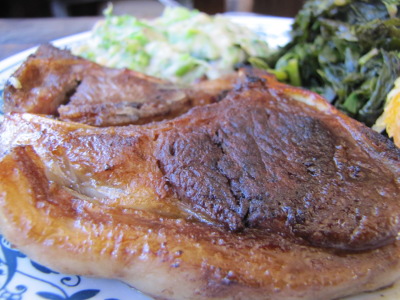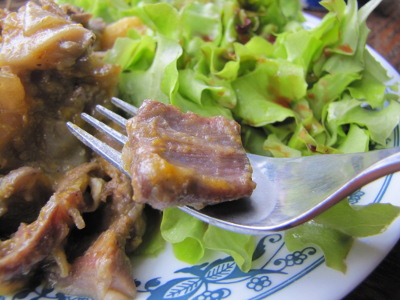
How to cook various cuts of lamb
 I
eased into cooking with meat by buying it ground, but have since been
branching out into using more and more of the whole animal.
Growing
our own broilers
trained me to use every bit of a chicken, and
now that we've bought a whole
lamb, I've been
doing the same with red
meat. It turns out that there are five main categories:
I
eased into cooking with meat by buying it ground, but have since been
branching out into using more and more of the whole animal.
Growing
our own broilers
trained me to use every bit of a chicken, and
now that we've bought a whole
lamb, I've been
doing the same with red
meat. It turns out that there are five main categories:
Ground
meat is the
easiest to cook with since you can make it into
burgers, sausage, or use it any other way you'd use hamburger or ground
turkey.
If I hadn't asked for the front legs of our lamb to be ground up, there
wouldn't
have been much ground meat, though, mostly from the belly.
Steaks are cuts that are tender
enough to fry or grill and eat with a knife and fork. Both chops and sirloin can be cooked as steaks,
with the latter being a bit more tender. Our pastured lamb
growers recommend searing lamb steaks over medium-high heat then
finishing up cooking at a lower temperature, which worked great for us.
Roasts are cuts that are a bit
tough to be fried up and should instead be either stewed over low heat
or baked in a cool oven for an hour or more. Letting them
marinate first  in an acidic marinate like
tomatoes or wine can also help tenderize the meat. Legs are the hind legs, cut whole
and looking a bit like a ham. Shanks are the upper arm (front
leg). Riblets are half bone and half fat
and meat --- they're the only part that I'm a bit at a loss about how
to cook.
in an acidic marinate like
tomatoes or wine can also help tenderize the meat. Legs are the hind legs, cut whole
and looking a bit like a ham. Shanks are the upper arm (front
leg). Riblets are half bone and half fat
and meat --- they're the only part that I'm a bit at a loss about how
to cook.
Bones won't come with your lamb
unless you specifically ask for them,
but you should! Bones make a wonderful broth, boiled for several
hours in a pot of water. The remains can be fed to your dog.
Heart
and liver are
cooked like any other organ meat. I sometimes
cook these up into broth, very occasionally fry up a liver for Mark,
and sometimes give the organs to the cats and dog as a health boost.
Once you learn to cook
meat in each of these categories, you'll be ready to cook nearly the
whole animal of just about every type of livestock out there.
With chickens, the meat type is more a factor of age than cut, but it's
still good to know how to grind or stew up old birds and to make broth
out of the bones. Even if you're not buying a whole animal,
cooking with unusual cuts allows you to buy cheaper meat that is just
as good for you, and to respect the meat animal by not tossing less
tender parts of their body.
Want more in-depth information? Browse through our books.
Or explore more posts by date or by subject.
About us: Anna Hess and Mark Hamilton spent over a decade living self-sufficiently in the mountains of Virginia before moving north to start over from scratch in the foothills of Ohio. They've experimented with permaculture, no-till gardening, trailersteading, home-based microbusinesses and much more, writing about their adventures in both blogs and books.
Want to be notified when new comments are posted on this page? Click on the RSS button after you add a comment to subscribe to the comment feed, or simply check the box beside "email replies to me" while writing your comment.

We have recently been using a obscure French style of cooking that breaks down the collagen in meats and pectin in vegetables to make them easier to eat. You guys are technical enough that you might enjoy this sort of thing.
sous-vide is cooking your food in a nylon/silicon vacuum bag that is placed in a temperature controlled water bath. The idea is over 200 years old, but only has been used in practice for the last 40 years.
For meats we cook them at 132F for 72 hours. For vegetables we cook them at 183F for 1-2 hours.
You can get into the setup for around $100 using a crock pot, temperature controller and vacuum sealer. It will make your meals more convenient and allow you to eat more of the lamb you purchased.
I just made a example video which helps illustrate this idea:
http://www.youtube.com/watch?v=glU77K-10hA&feature=player_embedded
Mike --- That sounds interesting, but I'm not sure I understand why it's more useful than just roasting tougher meat for a few hours in the oven. (Also, why would you cook vegetables that long? We try to minimize vegetable cooking time to maximize taste and vitamins.)
Robert --- Interesting! I'll have to check that out! I've been meaning to read her Radical Homemakers book for a while.
Anna,
The long cook times are for breaking down the toughness of meat (collagen) and the crunch of vegetables (pectin). The vitamins are preserved as there is no contact with outside moisture. It's not for everyone, but it is really popular right now in the geeky cooking blogs.
http://en.wikipedia.org/wiki/Sous-vide